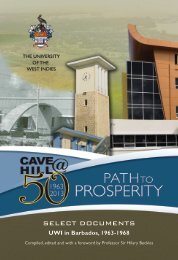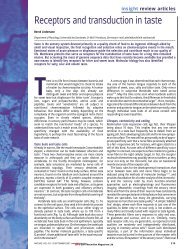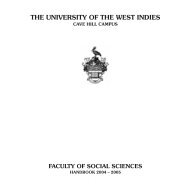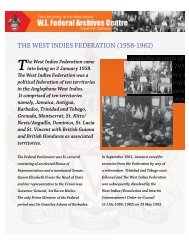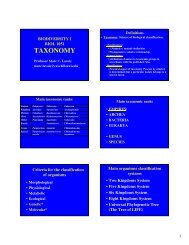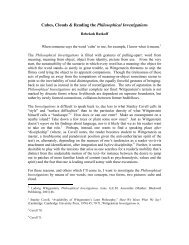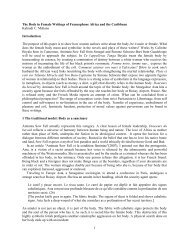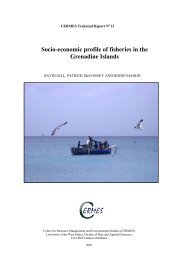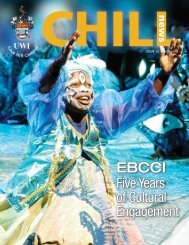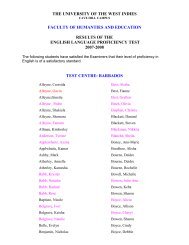THE SUSTAINABLE GRENADINES PROJECT - The University of ...
THE SUSTAINABLE GRENADINES PROJECT - The University of ...
THE SUSTAINABLE GRENADINES PROJECT - The University of ...
You also want an ePaper? Increase the reach of your titles
YUMPU automatically turns print PDFs into web optimized ePapers that Google loves.
1 INTRODUCTION<br />
<strong>The</strong>re is a lot <strong>of</strong> information available on the Grenadines Islands, which range from Isla Ronde in the South to<br />
Bequia in the North. This information covers many aspects <strong>of</strong> the Grenadines such as the economic, social and<br />
environmental issues which affect its people. However, the enormous potential <strong>of</strong> these studies, as a collection, has not<br />
been realized. <strong>The</strong> output has been made available at different times and sources and varies greatly in its quality and scope.<br />
As a result though the information exists, the time and effort which must be invested into obtaining it, is <strong>of</strong>ten an effective<br />
deterrent to doing so.<br />
This document provides an inventory and review <strong>of</strong> some <strong>of</strong> the environmental, social and economic information that can<br />
be found on the Grenadines. It is hoped that it will be useful to Non Governmental Organizations (NGOs), community<br />
members, and any other parties with any active interest in the area. This inventory is not considered to be complete as it has<br />
been based on what has become available, rather than on a systematic bibliographic search.<br />
2 ANNOTATED BIBLIOGRAPHY<br />
Adams, J.E. 1970a. Conch fishing industry <strong>of</strong> Union Island, Grenadines, West Indies. Trop. Sci., 12: 279-288.<br />
Since the late 1950s conch (Strombus gigas) fishing in Union Island had increased in importance to become the island's<br />
chief source <strong>of</strong> income in 1966. Conchs were found primarily between 2 to 9 fathoms <strong>of</strong> water on turtle grass (Thalassia<br />
testudinum) and manatee grass (Cymodocea manatorium) beds. <strong>The</strong> main gathering grounds on the south Grenada Bank are<br />
illustrated in the book. Details <strong>of</strong> the boats, effects <strong>of</strong> weather, transport and marketing, and earnings are given. Conchs<br />
were exported to Grenada and to Trinidad and although boats were not yet mechanized, over-exploitation was already<br />
evident at this point in time.<br />
Adams, J.E. 1970b. Marine industries <strong>of</strong> the St. Vincent and the Grenadines, West Indies Ph.D. <strong>The</strong>sis, Univ.<br />
Minnesota, Minneapolis, MN.<br />
Not seen.<br />
Adams, J.E. 1971. Historical geography <strong>of</strong> whaling in Bequia Island, West Indies. Caribb. 1971 Stud., 11(3): 55-74.<br />
Through most <strong>of</strong> the 19th century American whaling vessels took whales in the Windward Islands, primarily humpbacks.<br />
<strong>The</strong>se activities declined sharply after 1870. Locally, whaling remained important well into the first two decades <strong>of</strong> the 20th<br />
century. Details <strong>of</strong> the boats, the hunt, regulations, and the actual processing are given by the author.<br />
Adams, J.E. 1972a. <strong>The</strong> lobster fishing industry <strong>of</strong> Mt. Pleasant, Bequia Island, West Indies. Proceedings <strong>of</strong> the Gulf<br />
and Caribbean Fisheries Institute, 24:126-133.*<br />
<strong>The</strong> development <strong>of</strong> lobster fishing in Bequia, which intensified after about 1950, is described. Lobsters (Panulirus argus)<br />
were harvested by divers with spear guns and wire snares and transported live or chilled to Martinique until 1959; then to<br />
Grenada. In 1954 and 1965 respectively St. Vincent and Grenada regulated lobster fishing by 1) imposing a minimum total<br />
body length <strong>of</strong> 9 inches, 2) banning the capture <strong>of</strong> females with eggs, and 3) declaring a closed season from May 1 to<br />
September 30th. However, there was no limit on the number <strong>of</strong> legal-sized lobsters that could be caught in open season.<br />
Four divers working steadily over 7 days could catch as much as 3,000 lb. (2,000 individuals). However, the average catch<br />
was usually no more than half this amount. By 1964 lobster stocks on the Grenada Bank appeared to have been depleted<br />
and could no longer support the scale <strong>of</strong> fishery which had developed.<br />
Adams J. E. 1972b. Maritime industry <strong>of</strong> St. Vincent and the Grenadines. American Neptune, 32: 180-194.<br />
Not seen.<br />
Adams J. E. 1972c. Shore whaling in St. Vincent and the Grenadines. Caribbean Quarterly, 19(December 1973): 42-<br />
50.<br />
Not seen.<br />
1



